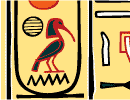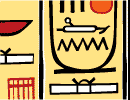Jan. 4, 2000 -- ASSOCIATED PRESS
King Tut's Clothes Recreated
By displaying re-creations of tunics, jackets and underwear found in Tutankhamen's 3,300-year-old tomb, creators of a museum exhibit in Sweden are hoping to breathe some life into the most famous of all Egyptian kings.
"Tutankhamen is not just a death mask, he was a living person. When you see somebody's clothes, you get a feeling for that person," exhibit director Gillian Vogelsang-Eastwood says.
The exhibit is the result of a first-of-its kind effort drawing on artisans from Japan to Italy to re-create some of the clothes, which were in pretty bad shape after three millennia.
Most of the originals, some of which are on display at the Egyptian Museum in Cairo, have lost their colors and the fabric is badly deteriorated.
"Some of the garments are just totally black," says Christina Rinaldo, an instructor at Boraas College's weaving school who helped create the exhibit. "Nobody would understand it. For the lay person (the exhibit) is one of the best ways to see Tutankhamen's clothing."
Experts like Rinaldo and Vogelsang-Eastwood, who is from the Stitching Textile Research Center in Leiden, Netherlands, were able to interpret the blacks and browns of the deteriorated textiles to discern their original colors.
The exhibit, which opened in October in Boraas, 260 miles southwest of Stockholm, travels to the Netherlands in April. Showings are also planned for San Diego; Chicago; Newark, N.J.; and Washington, D.C., as well as the European cities of Athens; London; Edinburgh, Scotland; and Leeds, England.
The garments on display range from elaborate, gold-ornamented tunics to a simple loincloth, a triangular fabric piece worn as underwear. All are made of hand-woven linen, simulating methods used in King Tut's times.
Rinaldo says modern machines weren't able to make thread thin enough to reproduce the fine linen needed, but she finally found Italian specialists who had the know-how.
The exhibit features 36 copies of the several hundred garments found in the tomb, Vogelsang-Eastwood says.
To Rinaldo, it's striking how modern King Tut's clothes look.
"It's so close to what we do today," she says. "It's so modern. It's the same embroidery technique we use today. The gloves are shaped like those we have today. The underwear look like fabric diapers from before the 1950s."





